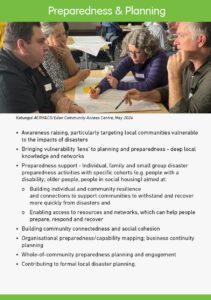Roles of social service NGOs in disaster management
Disaster Management* is the planning and implementation of actions in preparing for, responding to and recovering from disasters.
The Disaster Management Cycle includes:
- Preparedness & Planning
- Response
- Recovery
- Prevention & Mitigation

Each stage of the cycle is related to the others. The stages often merge into one another without clear start and end points.
The stages can occur concurrently, e.g. responding to a disaster while working on recovery from another.
Place-based social service NGOs may take on a number of roles in the Disaster Management Cycle in response to the needs of disaster-affected community.
NGOs do not have to be involved in all, or any, of the stages. Disaster management activities an NGO takes on are currently based on their capacity and mission, funding agreements, type of services provided and the level of impact of a disaster on service delivery.
Following are links to definitions for each stage of the Disaster Management Cycle and examples of how social service NGOs have taken on roles in each stage:
Preparedness & Planning
Disaster Preparedness*: ‘The knowledge and capacities developed by governments, response and recovery organizations, communities and individuals to effectively anticipate, respond to and recover from the impacts of likely, imminent or current disasters’.
Preparedness Support is information and guidance an NGO provides to people, particularly those identified as vulnerable or needing extra support, to develop their plan. Includes individual and group preparedness support sessions, use of tools such as the Person-Centred Emergency Preparedness (P-CEP) and Red Cross RediPlan.
NGOs may support disaster preparedness through community engagement and awareness activities which discuss disaster preparedness and how to reduce risks. Preparedness Support may be embedded in core service delivery or via targeted activities.
 | 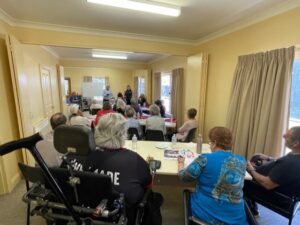 |
| Snowy Monaro Community Sector Disaster Capability Team Emergency Preparedness sessions | |
Disaster Planning: Arrangements made in advance to enable timely, effective and appropriate responses to specific potential hazardous events (e.g. flood, bushfire, earthquake, etc.) or emerging disasters.
The local knowledge, connections and trust between place-based social service NGOs and the community are essential to understanding local social vulnerabilities and assets. This can be used to engage the community and prepare for the impacts of disasters, ensuring no one is left behind. For examples of local hazard, vulnerability and capacities mapping, see the Risk, Vulnerabilities, Assets Mapping Tool.
NGOs may be active in supporting local disaster planning, for example via membership of committees or participating in local scenario events. For examples of how social service NGOs are involved in Planning, see Case Study_Influencing Emergency Management governance.
Organisational Planning: Social service NGOs are usually required by funding bodies to have business continuity plans to support service delivery through an emergency. Organisational planning may also contribute to local community disaster plans. Planning for disasters by local social service NGOs’ might cover:
- how the organisation plans to operate, including – if possible – continuing core service delivery during a disaster
- how the organisation could respond to increased service demand after a disaster
- strategies to ensure the preparedness, safety and wellbeing of staff and volunteers
- any disaster-related role the organisation might take on as part of coordinated local efforts.
The Community Sector Disaster Capability Team in Northern Rivers created QuickTips for NGOs planning for disasters, Disaster Ready Together QuickTips (PDF).
For tools to help NGOs prepare for disaster, see See Tools & Resources: Planning & Preparedness
Response
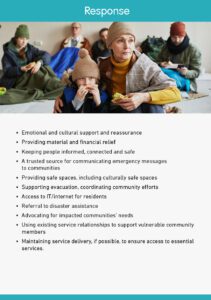 Disaster Response*: Actions taken directly before, during or immediately after a disaster in order to save lives, reduce health impacts, ensure public safety and meet the basic subsistence needs of the people affected.
Disaster Response*: Actions taken directly before, during or immediately after a disaster in order to save lives, reduce health impacts, ensure public safety and meet the basic subsistence needs of the people affected.
Important Note: In NSW, Disaster Response is led by Combat Agencies such as NSW Police, NSW State Emergency Services (SES) and Rural Fire Service, and supported by nominated agencies. These roles are described in legislation and defined in the NSW Emergency Management Plan (EMPLAN) and supporting Plans. More detail is provided in the Emergency Management Governance & NGOs section.
Increasingly, local social service NGOs are using the skills and resources central to their day-to-day activities to meet the material and emotional wellbeing needs of disaster-affected people.
Case studies
Following are some case studies from services that have supported their community during and immediately after disaster:
Case Study: Supporting the community through floods.
North West Community Services, formerly Riverstone Neighbourhood Centre podcast & Case Study
See Tools & Resources: Response
Recovery
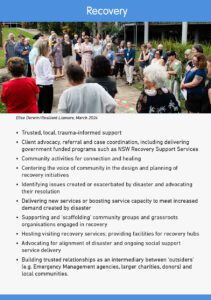 Disaster Recovery*: The restoring or improving of livelihoods and health, as well as economic, physical, social, cultural and environmental assets, systems and activities, of a disaster-affected community or society. Aligning with the principles of sustainable development and “build back better”, to avoid or reduce future disaster risk.
Disaster Recovery*: The restoring or improving of livelihoods and health, as well as economic, physical, social, cultural and environmental assets, systems and activities, of a disaster-affected community or society. Aligning with the principles of sustainable development and “build back better”, to avoid or reduce future disaster risk.
Social service NGOs support their communities through the often long process of disaster recovery.
Case studies
Following are some disaster recovery experiences from services and communities.
Case Study: Supporting the community after bushfires
Podcast: The Family Place Moruya
See Tools & Resources: Recovery
Prevention & Mitigation
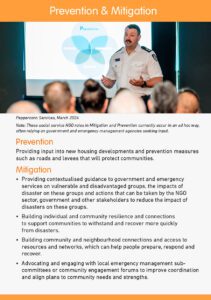 Disaster Prevention*: Activities and measures to avoid existing and new disaster risks. Examples include land-use regulations that do not permit any settlement in high-risk zones and immunization against vaccine-preventable diseases.
Disaster Prevention*: Activities and measures to avoid existing and new disaster risks. Examples include land-use regulations that do not permit any settlement in high-risk zones and immunization against vaccine-preventable diseases.
Disaster Mitigation*: The lessening or minimising of the adverse impacts of a hazardous event. The adverse impacts of hazards, in particular natural hazards, often cannot be prevented fully, but their scale or severity can be substantially lessened by various strategies and actions, including improved environmental and social policies and public awareness.
NGOs can support disaster mitigation by bringing in-depth local knowledge and understanding of community to emergency management agencies and systems. Activities can include providing advice, assisting with planning and building capabilities and linkages to local service and community networks. For example:
- Training, sector development and peer-based learning which build social service NGOs’ understanding of emergency management and disaster capabilities
- Participating in forums and engagement structures which bring social service NGOs’ perspectives to emergency management agencies and decision-makers
- Engaging with Emergency Management personnel and agencies to improve understanding of vulnerability (‘vulnerability literacy’), and
- Inputting or co-designing Emergency Management governance and engagement structures which bring community and NGO knowledge, methods and skills to Emergency Management agencies.
Nimbin Neighbourhood & Information Centre has worked extensively with the local community and emergency services to develop:
- the Nimbin Emergency Radio Network (NERN)
- the Community Care Team (CCT)
- Nimbin Community Disaster Plan
As a formal, funded community service organisation, Nimbin Neighbourhood & Information Centre have provided the ‘scaffold’ for local community groups to undertake locally-led disaster planning.
Understanding local disaster risks, vulnerabilities and assets
Another important aspect of disaster mitigation is understanding local hazards, vulnerabilities and assets. We know from recent experience that certain communities and population groups are more vulnerable and most impacted when disasters strike.
Disaster risk can be reduced by understanding local hazards and who may be most exposed to them, as well as who is already experiencing vulnerability (e.g. poverty, homelessness, etc.) and the capacities and assets that exist in the community.
Natural Hazard* is a natural phenomenon that may cause loss of life, injury or other health impacts, property damage, social and economic disruption or environmental degradation.
Vulnerability* The physical, social, economic and environmental factors or processes which increase the susceptibility of an individual, a community, assets or systems to the impacts of hazards.
Disaster Risk* is the potential loss of life, injury, or destroyed or damaged assets as a result of a disaster. Disaster risk is measured by the interaction between hazard, exposure, vulnerability and capacity.
Disaster risk reduction (DRR)* is the work we do before a hazard event (e.g. flood, fire, storm, earthquake, etc.) occurs, to reduce the impact.
Hazards, Vulnerability & Assets
The Community Sector Disaster Capability Project has assessed local hazards, socioeconomic vulnerabilities and community assets:
∗ Disaster definitions used on this page are from UNDRR, Sendai Framework Terminology on Disaster Risk Reduction
See Tools & Resources: Prevention & Mitigation
The NCOSS Disaster Support webpages are part of the Community Sector Disaster Capability Project. The Project, a partnership between NCOSS, AbSec and the Local Community Services Association (LCSA), was jointly funded by the Australian and NSW Governments under the National Partnership Agreement on Disaster Risk Reduction, through a Disaster Risk Reduction Fund grant. The CSDC Project was completed in June 2024.
 |  |  | 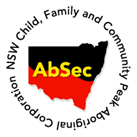 |

